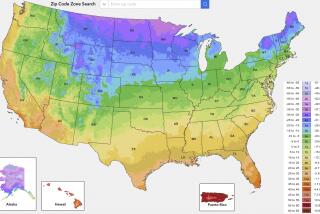How to keep plants alive in this blistering summer heat
A friend went to Portland, Ore., for a getaway and felt pretty smug about missing the recent SoCal heat wave, until he returned and surveyed the wreckage around his Pasadena home.
“Lost many plants in my yard,” he texted. “Very upsetting. Blow torch.”
We know the feeling.
The blast of heat that ushered in July has scalded tomatoes on the vine, shriveled leaves and crisp-ified roses across Southern California.
At Descanso Gardens, where the temperature jumped from 74 to 114 degrees in a single day earlier this month, most of its fabled camellias were damaged by sunburn, said Rachel Young, director of horticulture and garden operations at the La Cañada Flintridge site.
With proper care, Young thinks the plants will recover and bloom this winter, but damaged flowers, fruits and vegetables are another story.
“I had grapes at home that were just about ripe,” she said, “but that evening, they were raisins, and I don’t like raisins.”
Yes, temperatures have been awful, but there are ways to salvage and protect your plants from the blistering heat, say Young and Yvonne Savio, retired director of Los Angeles County’s master gardener program who now runs gardeninginla.net. Here are their tips for dealing with the heat. Remember to grab a hat, lots of water and sun protection gear of your own before heading into your garden.
1. Water deep
Deep watering at the base of the plant for a long time is the best way to revive and protect plants, because it coaxes roots deeper into the ground. “Plants are like people, they get lazy,” Young said. “If they get water for 5 minutes every day, they keep their roots near the surface, so by watering deeply you’re training the plants to send their roots deep in the soil where the water is.” In general, Young recommends deep watering most plants once a week. For how long? It depends on your soil, but long enough to saturate the soil a good foot in depth. Vegetables might need deep watering two or three times a week when it’s really hot, she added. How she does it: Savio sinks 5-gallon planting containers (the type with drain holes) between plants in her garden and then fills them three times with water, once a week.
When you know a hot spell is on the way, you can also prepare by watering deeply at ground level, ideally at night, when the air is cooler.
2. But don’t overwater
Plants sometimes wilt from the severe sun, even when they have sufficient water. Test the soil before you water, Young said. If a pot feels heavy or the soil feels damp an inch or so under the ground, your plant probably doesn’t need more moisture.
3. No water in the sun
As tempting as it sounds, don’t hose down your plants in the middle of the day; those water droplets turn into mini magnifying glasses on the leaves and intensify the heat. Savio does recommend spraying plants to cool them down, but only after the sun sets.
4. Set up some shade
A big beach umbrella works, as do airy (30% to 40%) shade cloths. You can also use old bed sheets, rigged-up cheesecloth or propped-up cardboard to give your plants a break from the scorching rays. The key is to make sure your shade props allow air to circulate freely around the plants. If the only cloth you have handy is dark in color, remember that it can absorb heat and can in turn burn any foliage they touch, so keep it several inches above or away from the plants. Here’s an easy D.I.Y. garden shade you can make out of PVC piping and a bed sheet, and more shade idea>>>.
5. Don’t remove damaged foliage
Those brown leaves and branches serve as protection against additional damage and could actually be harboring living tissue, so hands off the pruners, at least for now.
6. Stop all pruning until fall
Even plants that look OK are going to be stressed in this heat, and pruning just adds to it. Let them grow as they wish and prune when it’s cooler.
7. Forget the fertilizer
Root systems suffer in high heat; absorbing fertilizer can do further damage. Straight compost and low-nitrogen (numbers less than 3) organic fertilizers are OK, Young said, if they don’t include manure, fish or blood, because those contain salts, which can cause heat stress and burning.
8. Tomatoes etc.
Sad to say, those blistered baby tomatoes, peppers, squash and beans aren’t going to miraculously ripen on the vine, Savio said. Remove them so the mama plants can focus on recovering. Don’t expect more fruit to set until the temperatures dip below 85 to 90 degrees for 10 days in a row.
9. Roses
The no-pruning rule doesn’t apply to roses, because they are so susceptible to disease. “You don’t want to leave a ton of dead tissue for diseases and insects,” Young said, so remove withered blooms and branches.
10. Container plants
Avoid dark-colored containers, which absorb the heat more than lighter colors and can actually fry a plant’s roots, Young said. Try putting potted plants inside larger pots to give them some insulation and shade, but make sure both pots have good drainage. Plants drown in standing water, even when it’s hot.
More to Read
Sign up for our L.A. Times Plants newsletter
At the start of each month, get a roundup of upcoming plant-related activities and events in Southern California, along with links to tips and articles you may have missed.
You may occasionally receive promotional content from the Los Angeles Times.







